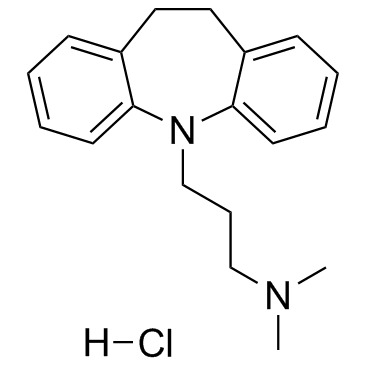Imipramine hydrochloride

Imipramine hydrochloride structure
|
Common Name | Imipramine hydrochloride | ||
|---|---|---|---|---|
| CAS Number | 113-52-0 | Molecular Weight | 316.868 | |
| Density | 1.041g/cm3 | Boiling Point | 403.1ºC at 760mmHg | |
| Molecular Formula | C19H25ClN2 | Melting Point | 168-1700C | |
| MSDS | USA | Flash Point | 179.7ºC | |
| Symbol |

GHS07 |
Signal Word | Warning | |
|
Antidepressants activate the lysophosphatidic acid receptor LPA(1) to induce insulin-like growth factor-I receptor transactivation, stimulation of ERK1/2 signaling and cell proliferation in CHO-K1 fibroblasts.
Biochem. Pharmacol. 95 , 311-23, (2015) Different lines of evidence indicate that the lysophosphatidic acid (LPA) receptor LPA1 is involved in neurogenesis, synaptic plasticity and anxiety-related behavior, but little is known on whether this receptor can be targeted by neuropsychopharmacological a... |
|
|
Developing structure-activity relationships for the prediction of hepatotoxicity.
Chem. Res. Toxicol. 23 , 1215-22, (2010) Drug-induced liver injury is a major issue of concern and has led to the withdrawal of a significant number of marketed drugs. An understanding of structure-activity relationships (SARs) of chemicals can make a significant contribution to the identification o... |
|
|
A predictive ligand-based Bayesian model for human drug-induced liver injury.
Drug Metab. Dispos. 38 , 2302-8, (2010) Drug-induced liver injury (DILI) is one of the most important reasons for drug development failure at both preapproval and postapproval stages. There has been increased interest in developing predictive in vivo, in vitro, and in silico models to identify comp... |
|
|
Chemical genetics reveals a complex functional ground state of neural stem cells.
Nat. Chem. Biol. 3(5) , 268-273, (2007) The identification of self-renewing and multipotent neural stem cells (NSCs) in the mammalian brain holds promise for the treatment of neurological diseases and has yielded new insight into brain cancer. However, the complete repertoire of signaling pathways ... |
|
|
The effect of curcumin on the brain-gut axis in rat model of irritable bowel syndrome: involvement of 5-HT-dependent signaling.
Metab. Brain Dis. 30(1) , 47-55, (2015) Irritable bowel syndrome (IBS) is induced by dysfunction of central nervous and peripheral intestinal systems, which affects an estimated 10-15% population worldwide annually. Stress-related psychiatric disorders including depression and anxiety are often com... |
|
|
Effects of a glycine transporter-1 inhibitor and D-serine on MK-801-induced immobility in the forced swimming test in rats.
Behav. Brain Res. 278 , 186-92, (2015) Glutamatergic dysfunction, particularly the hypofunction of N-methyl-D-aspartate (NMDA) receptors, is involved in the pathophysiology of schizophrenia. The positive modulation of the glycine site on the NMDA receptor has been proposed as a novel therapeutic a... |
|
|
Genetic mapping of targets mediating differential chemical phenotypes in Plasmodium falciparum.
Nat. Chem. Biol. 5 , 765-71, (2009) Studies of gene function and molecular mechanisms in Plasmodium falciparum are hampered by difficulties in characterizing and measuring phenotypic differences between individual parasites. We screened seven parasite lines for differences in responses to 1,279... |
|
|
Azure B and a synthetic structural analogue of methylene blue, ethylthioninium chloride, present with antidepressant-like properties.
Life Sci. 117(2) , 56-66, (2015) The phenothiazinium compound, methylene blue (MB), possesses diverse pharmacological actions and is attracting attention for the treatment of bipolar disorder and Alzheimer's disease. MB acts on both monoamine oxidase (MAO) and the nitric oxide (NO)-cGMP path... |
|
|
Effect of reversible ligands on oxime-induced reactivation of sarin- and cyclosarin-inhibited human acetylcholinesterase.
Toxicol. Lett. 232(3) , 557-65, (2015) Poisoning by organophosphorus compounds (OP) used as pesticides and nerve agents is due to irreversible inhibition of the enzyme acetylcholinesterase (AChE). Oximes have been widely recognized for their potency to reactivate the inhibited enzyme. The limited ... |
|
|
The effects of antidepressants "fluoxetine and imipramine" on vascular abnormalities and Toll like receptor-4 expression in diabetic and non-diabetic rats exposed to chronic stress.
PLoS ONE 10(3) , e0120559, (2015) Several studies reveal that diabetes doubles the odds of comorbid depression with evidence of a pro-inflammatory state underlying its vascular complications. Indeed, little information is available about vascular effects of antidepressant drugs in diabetes.We... |